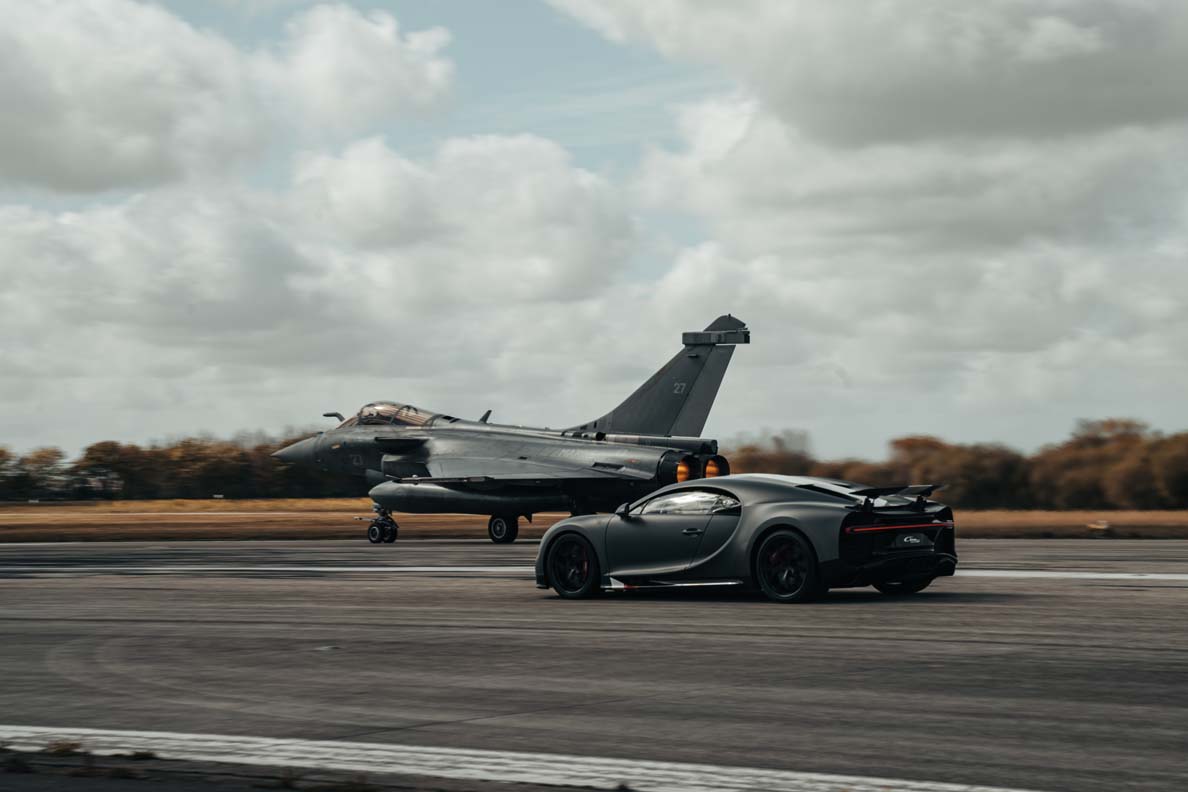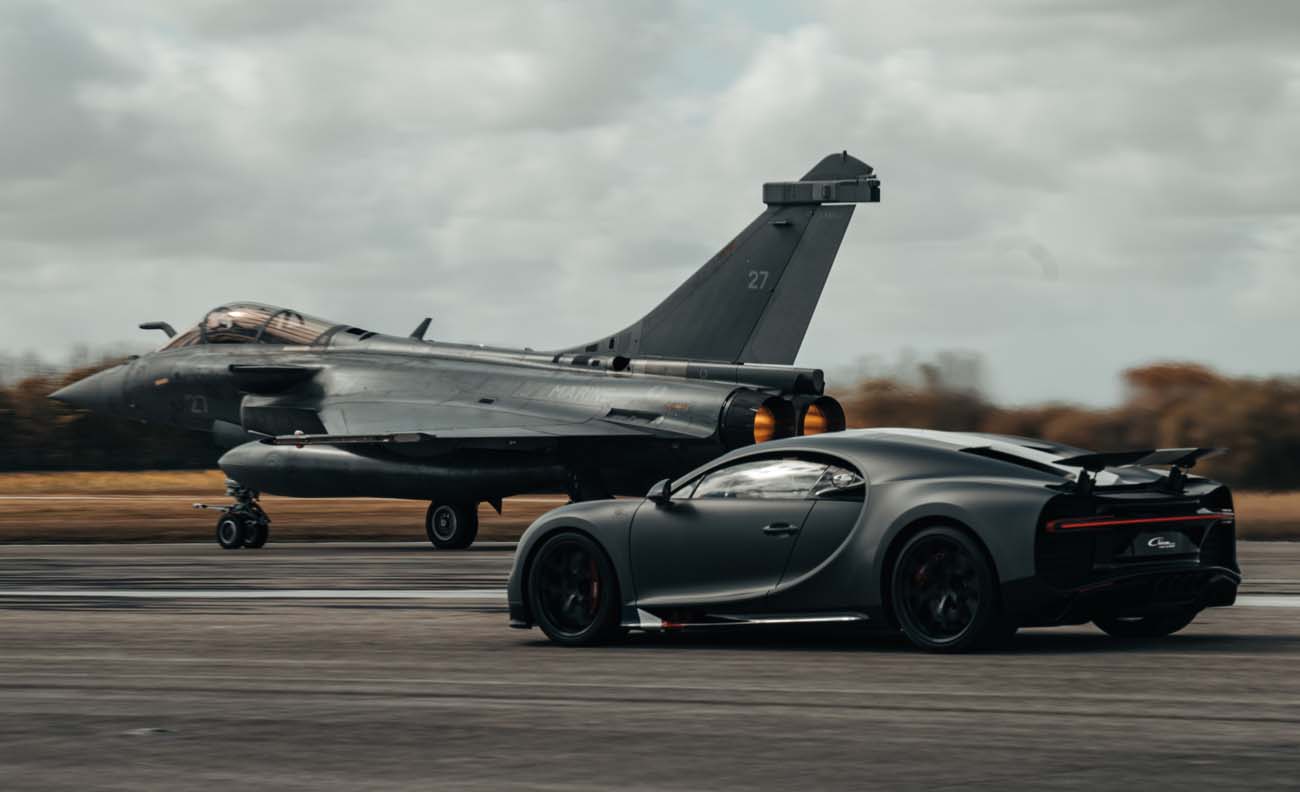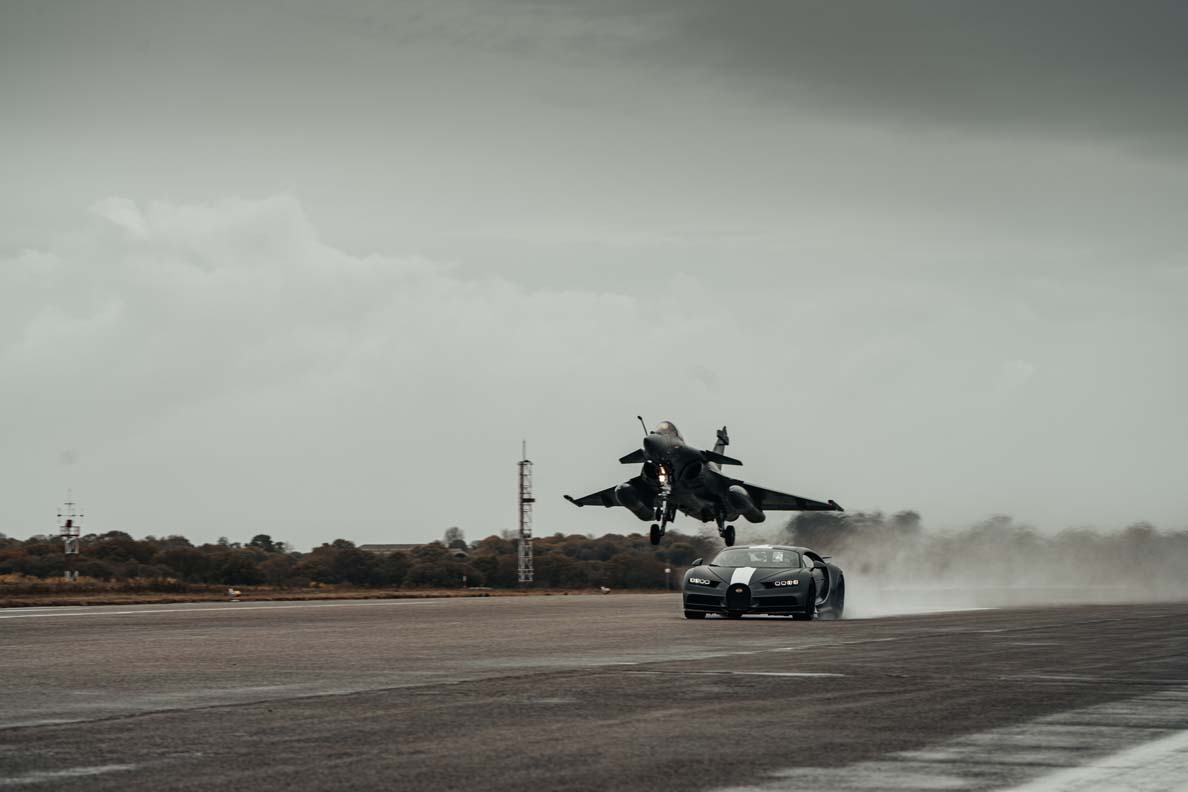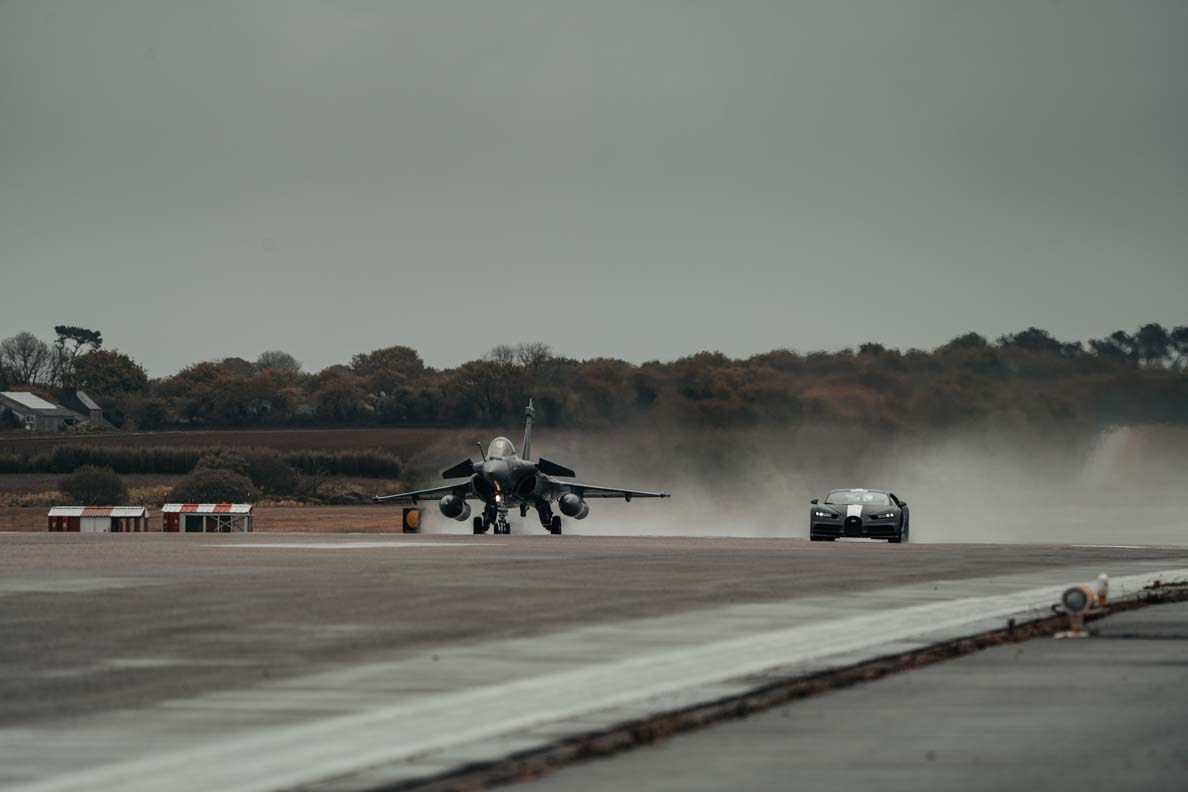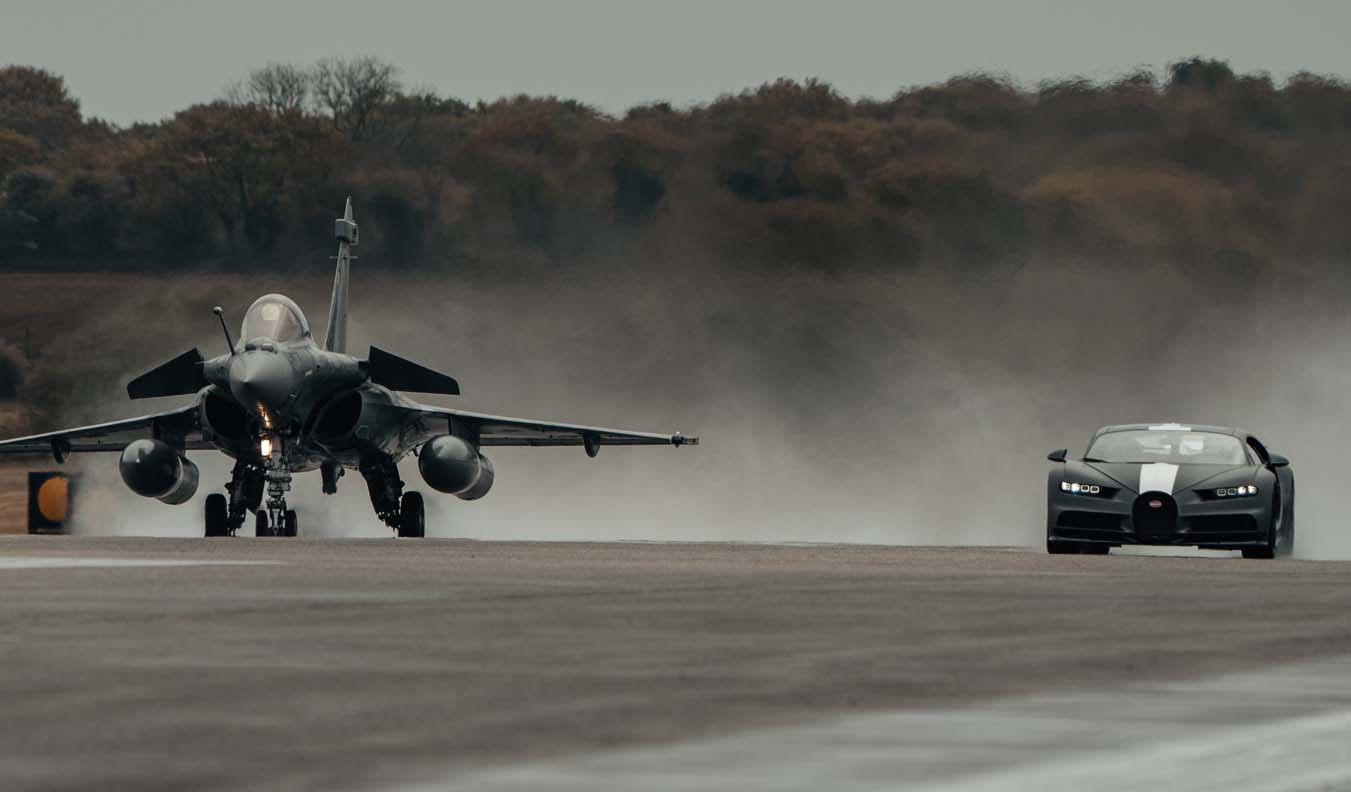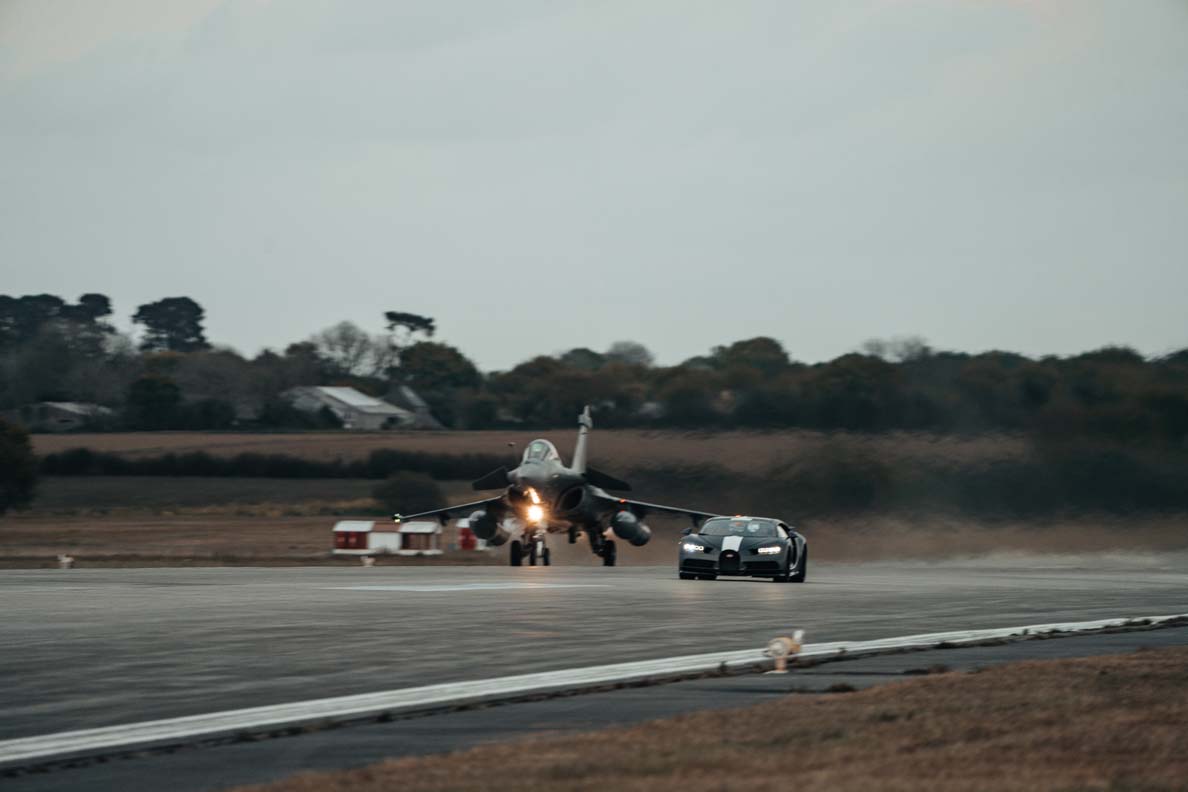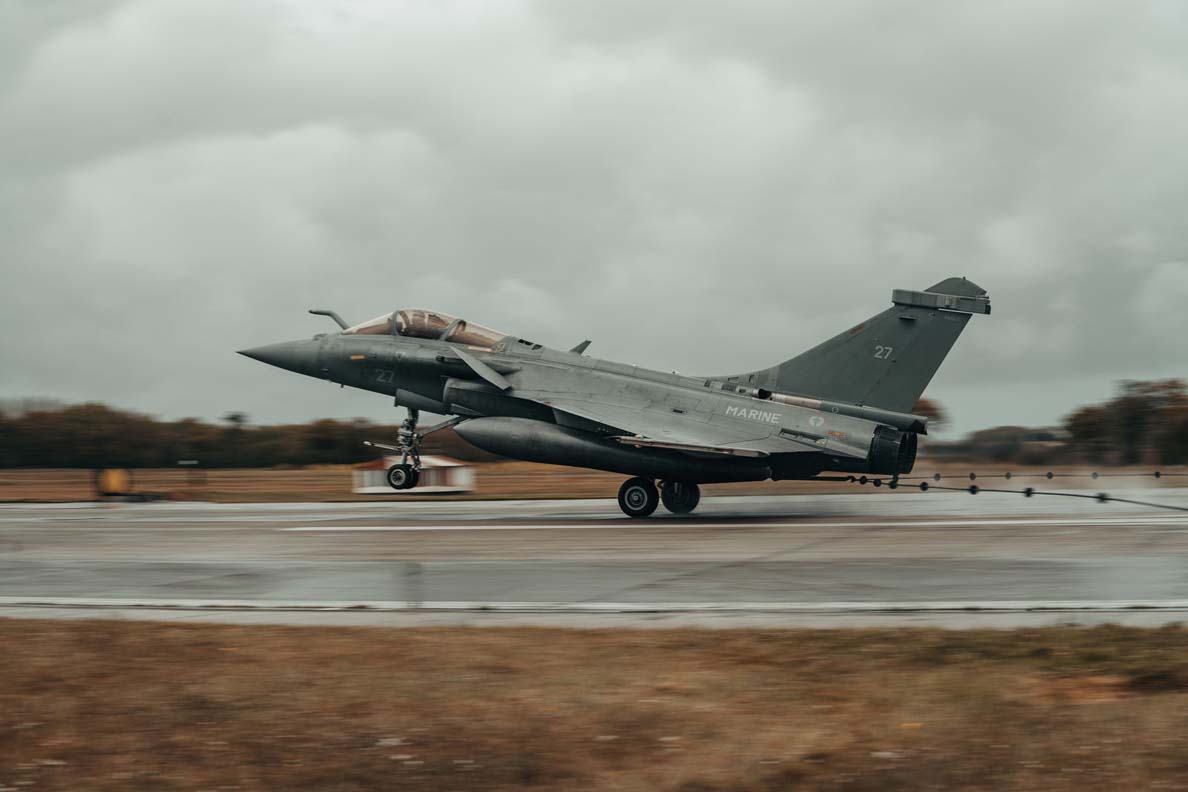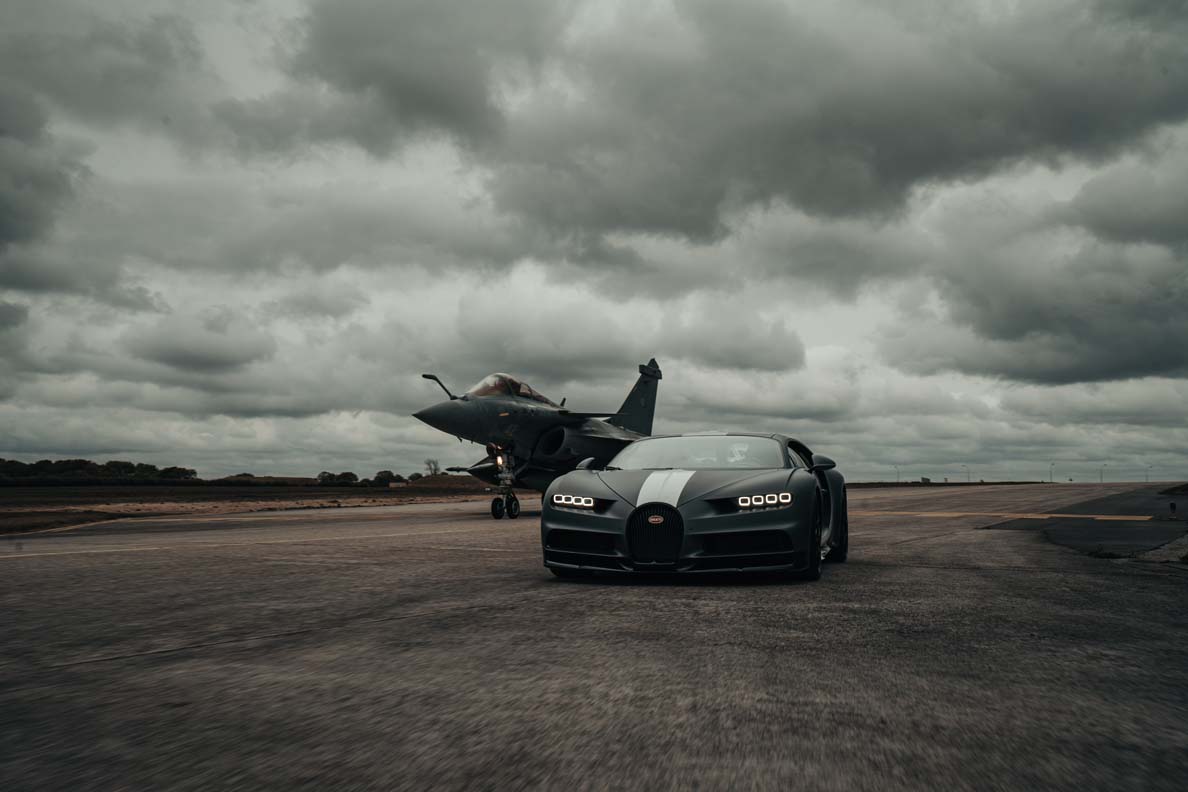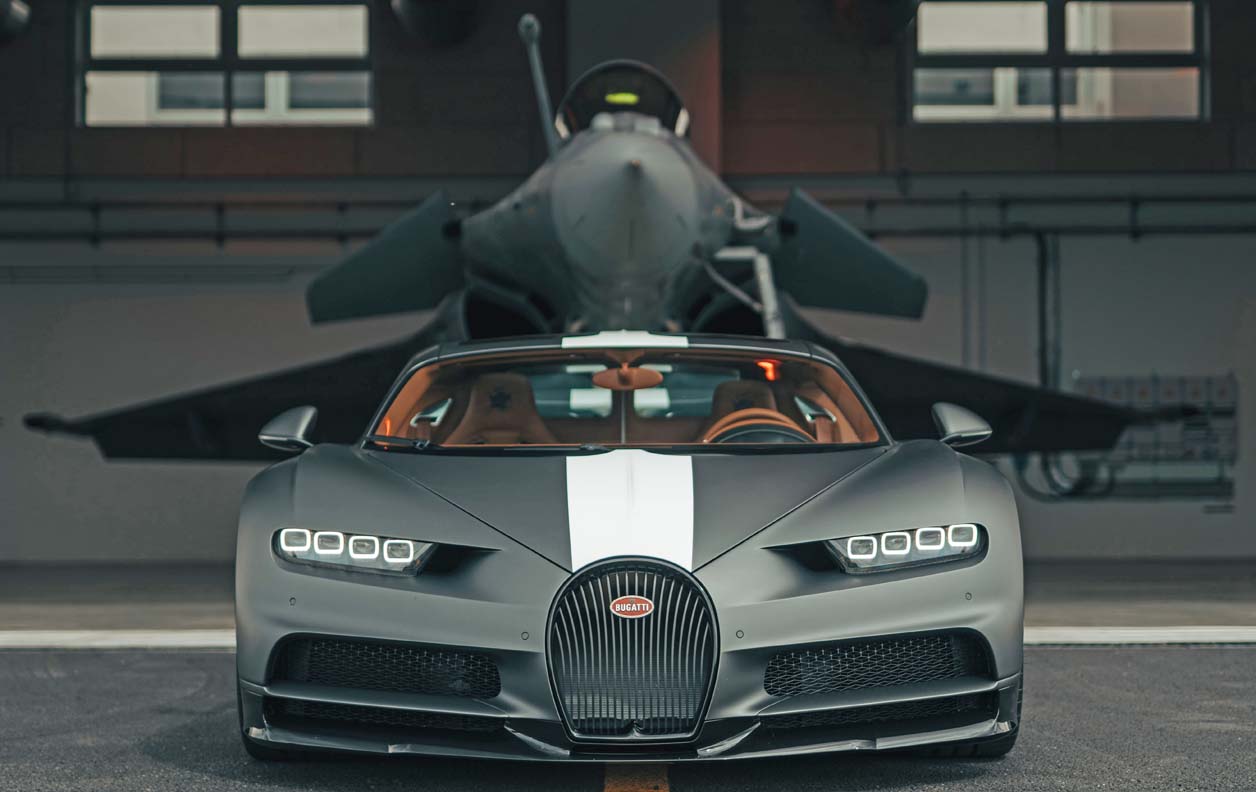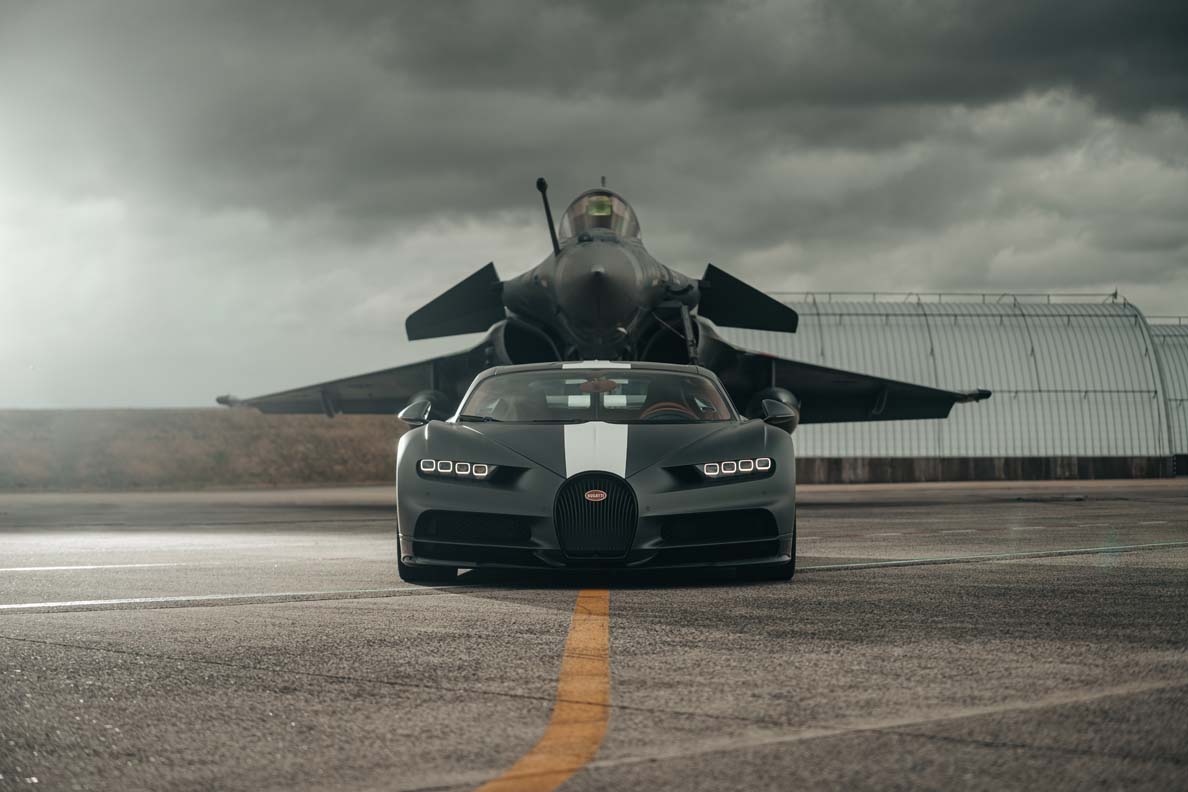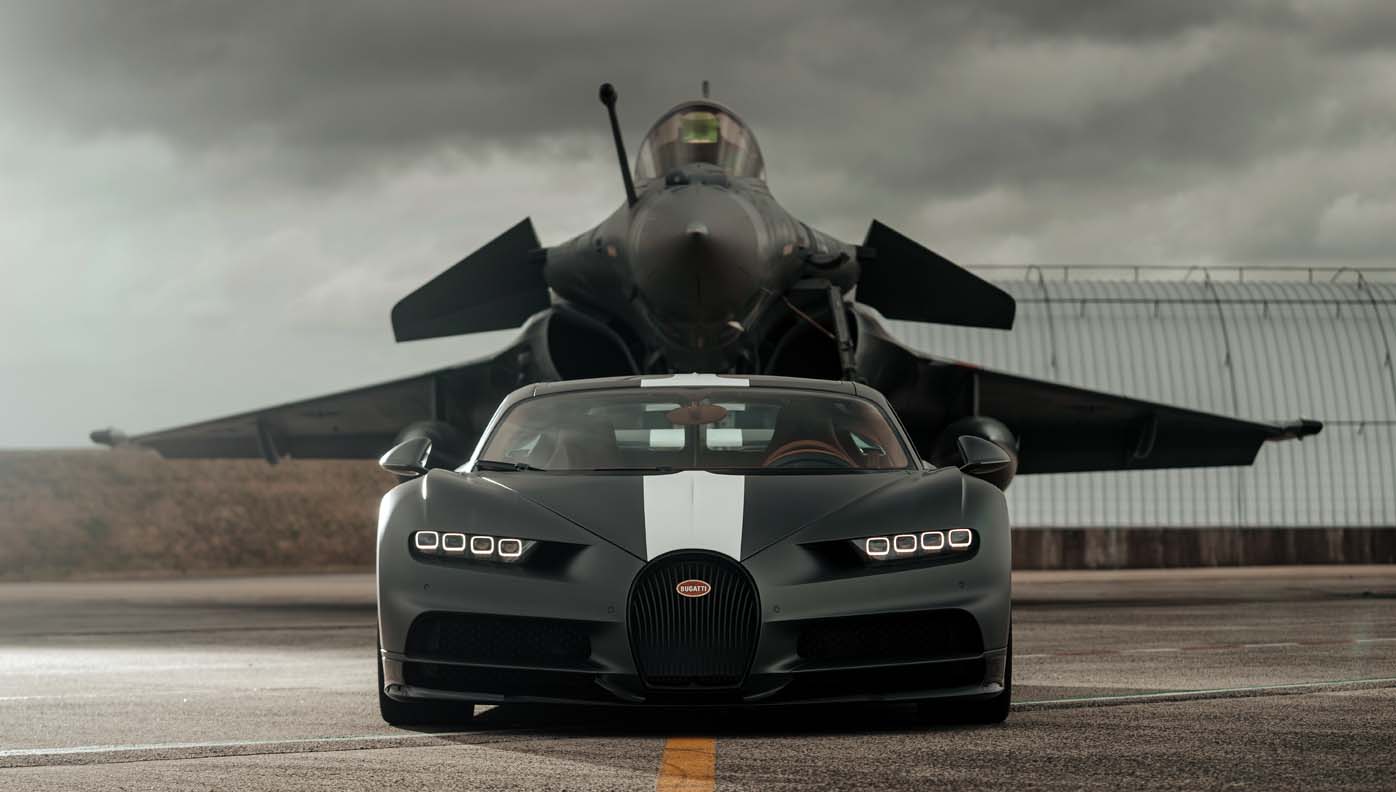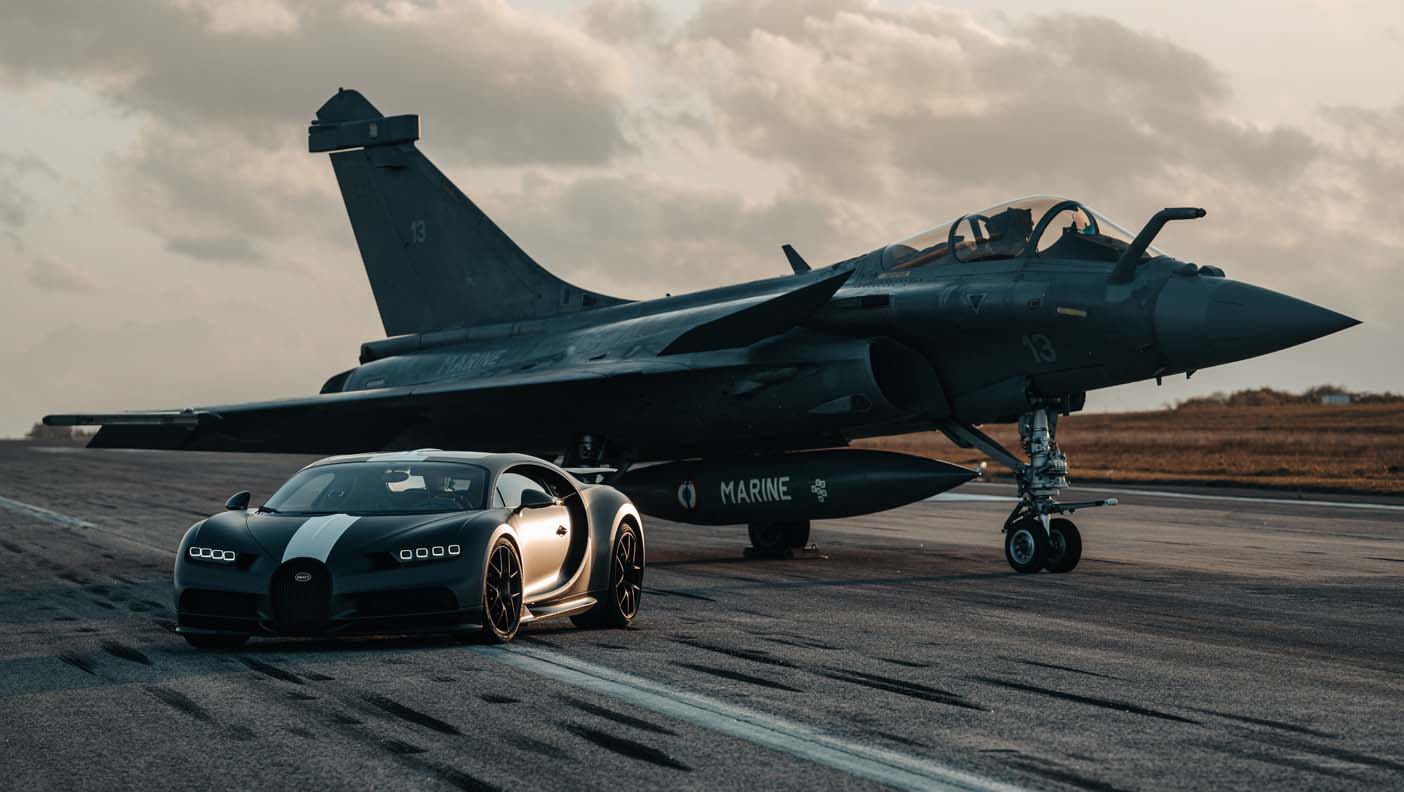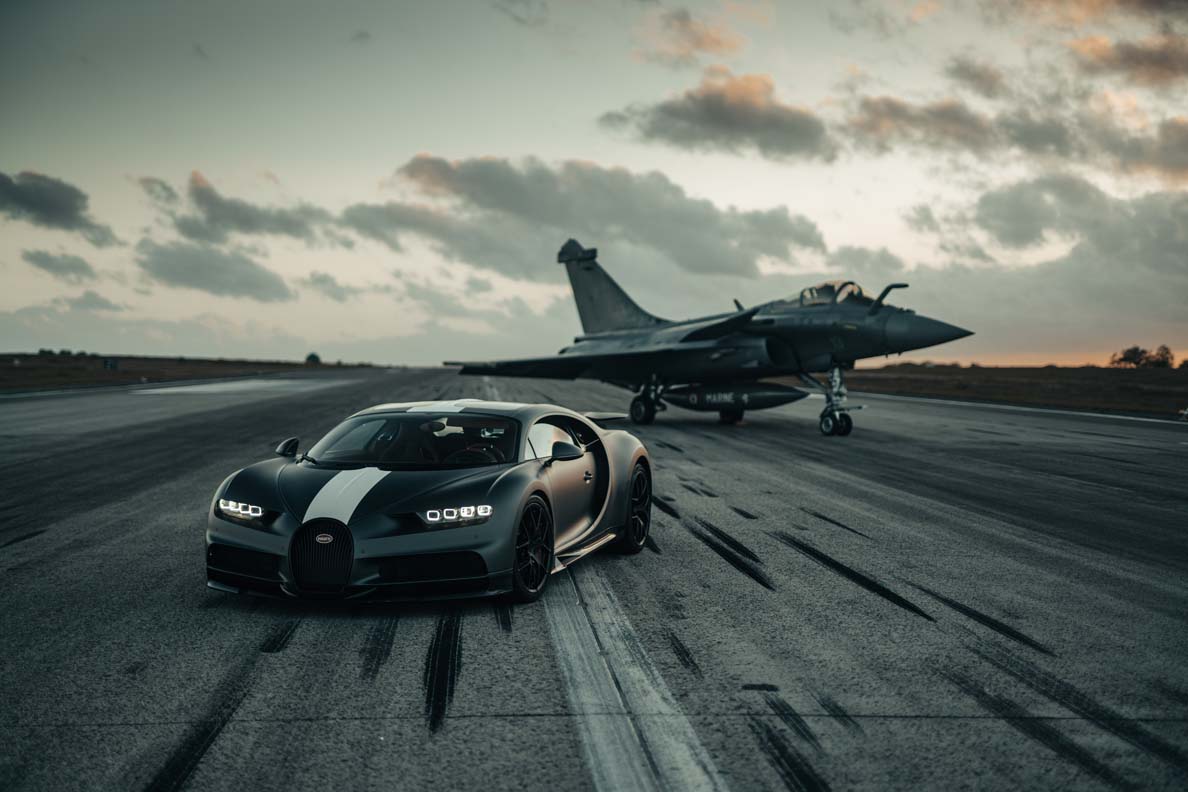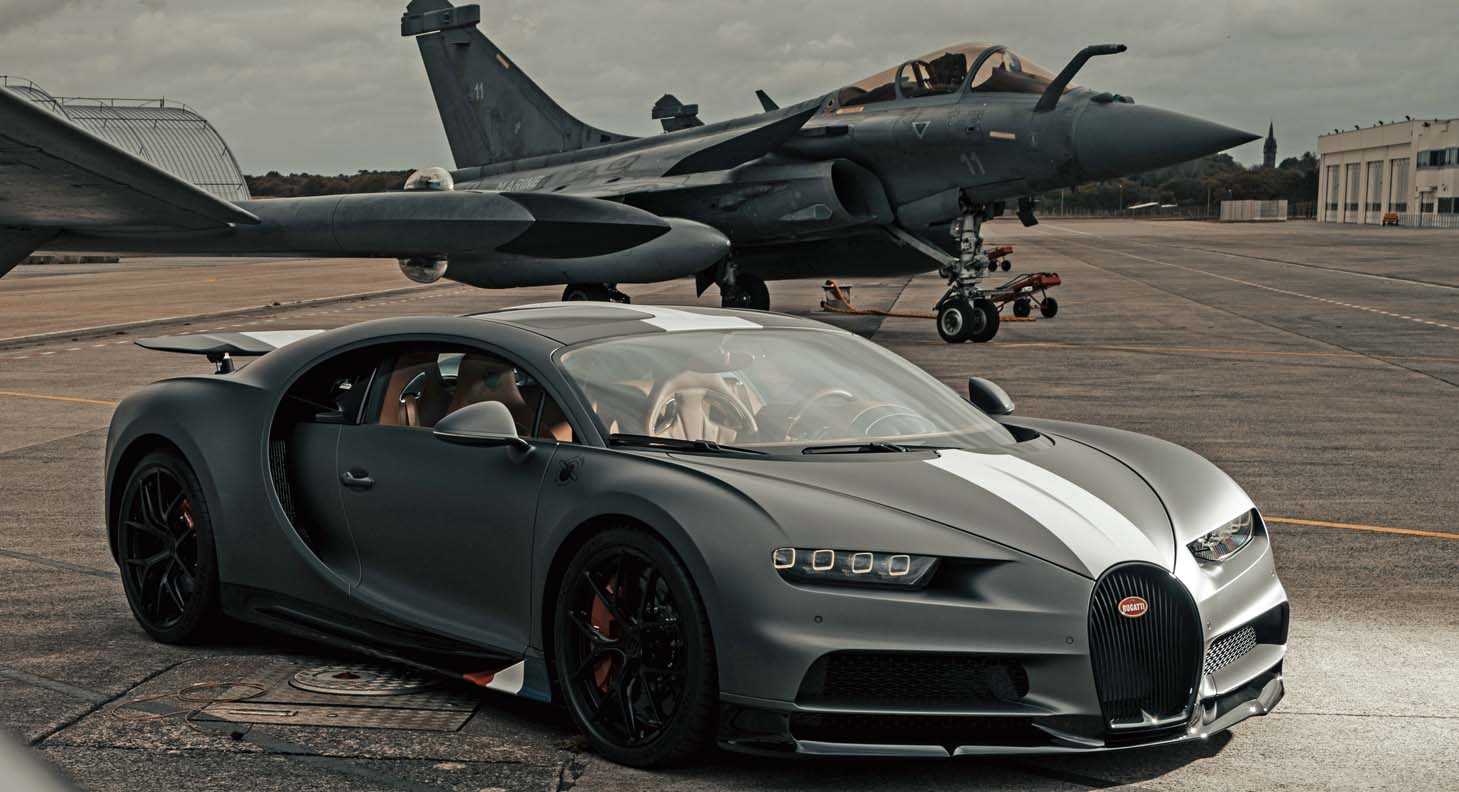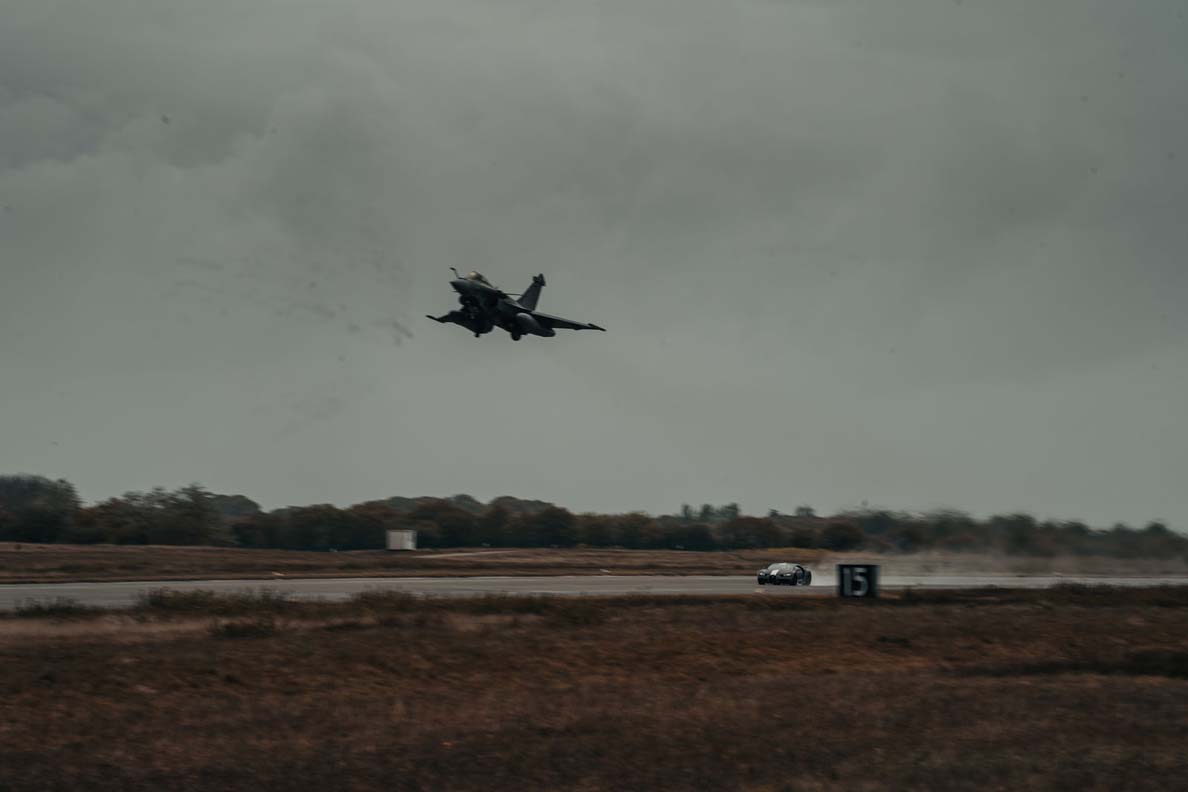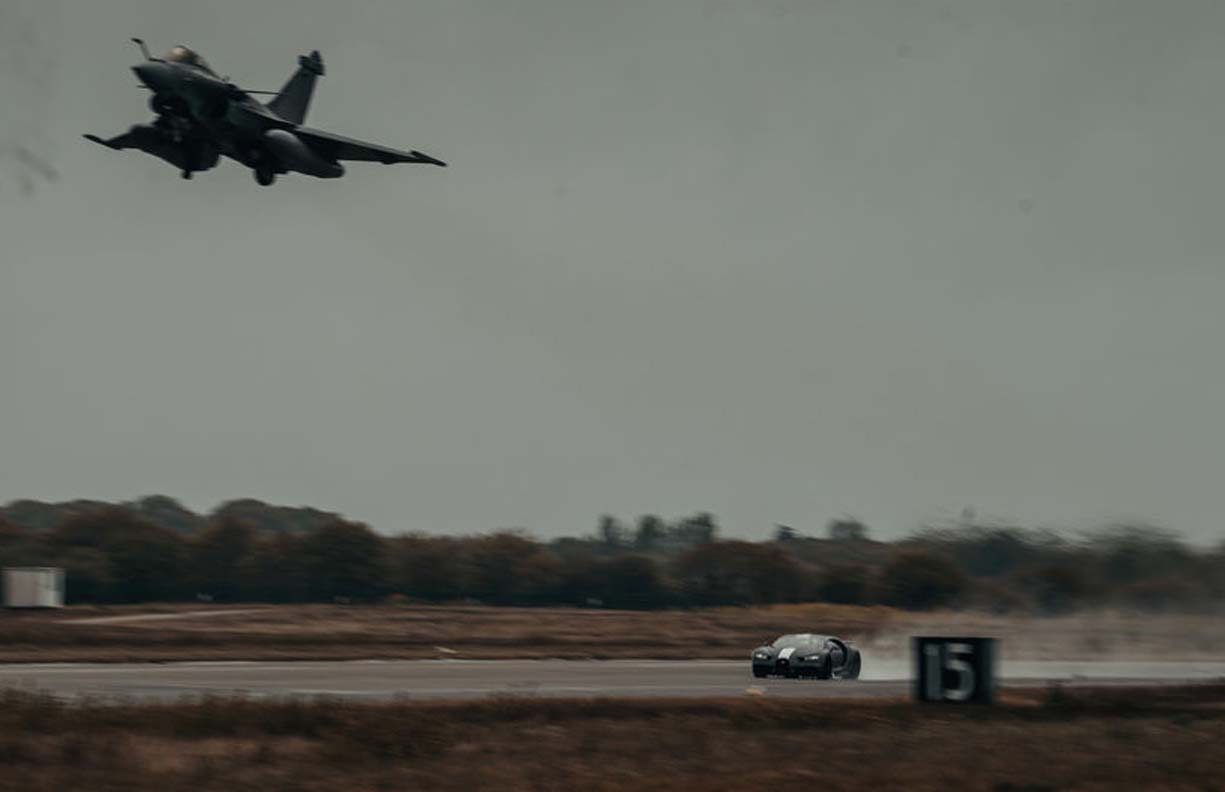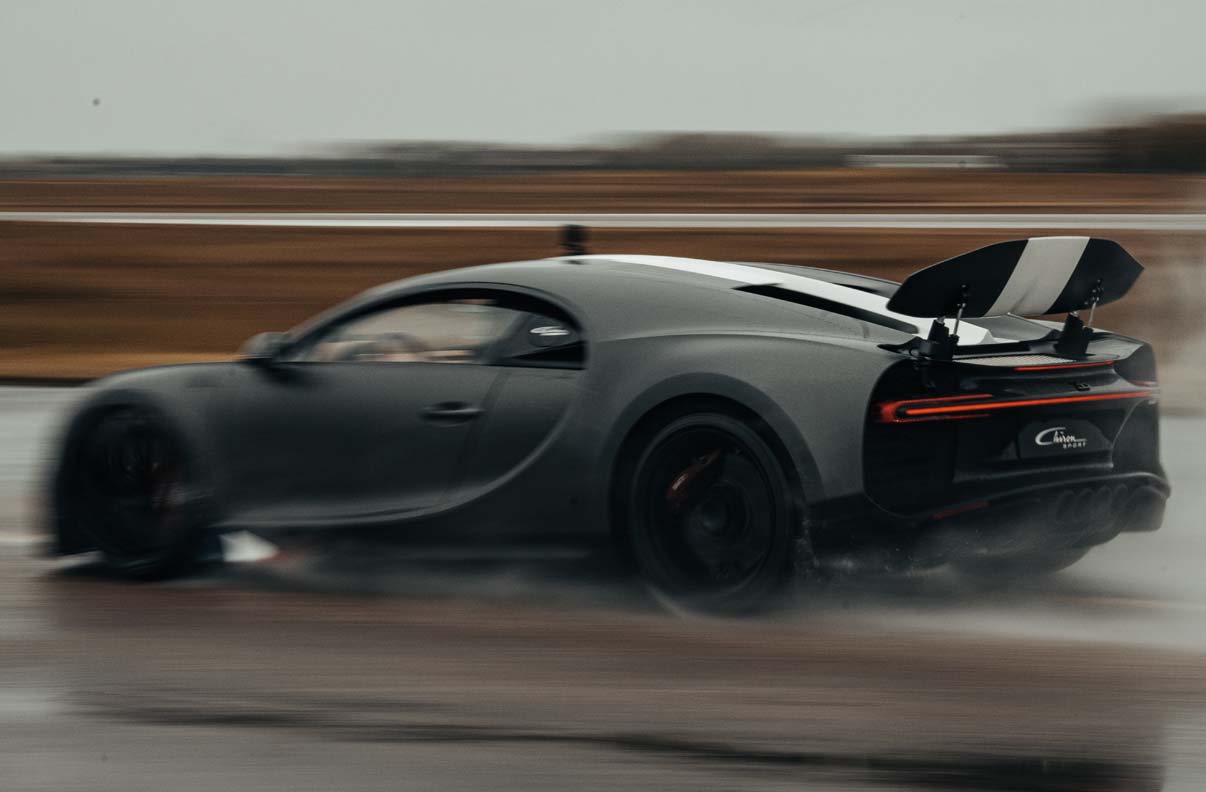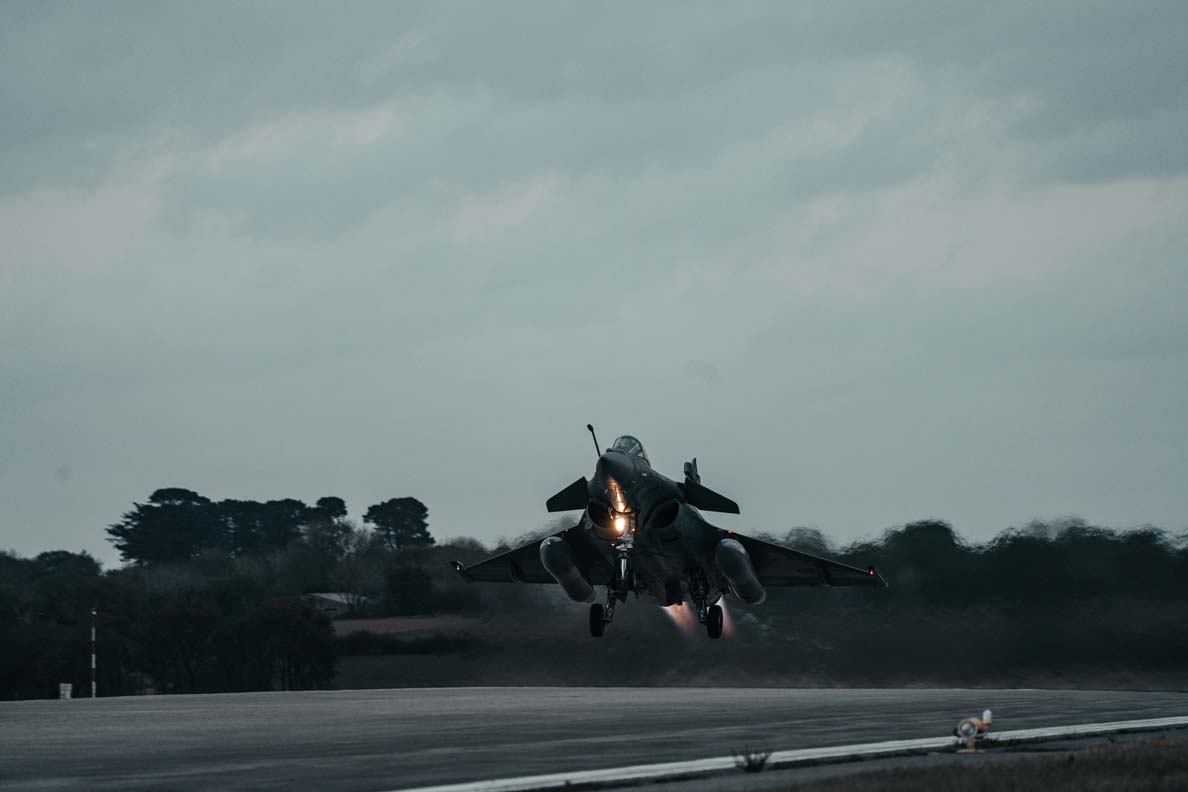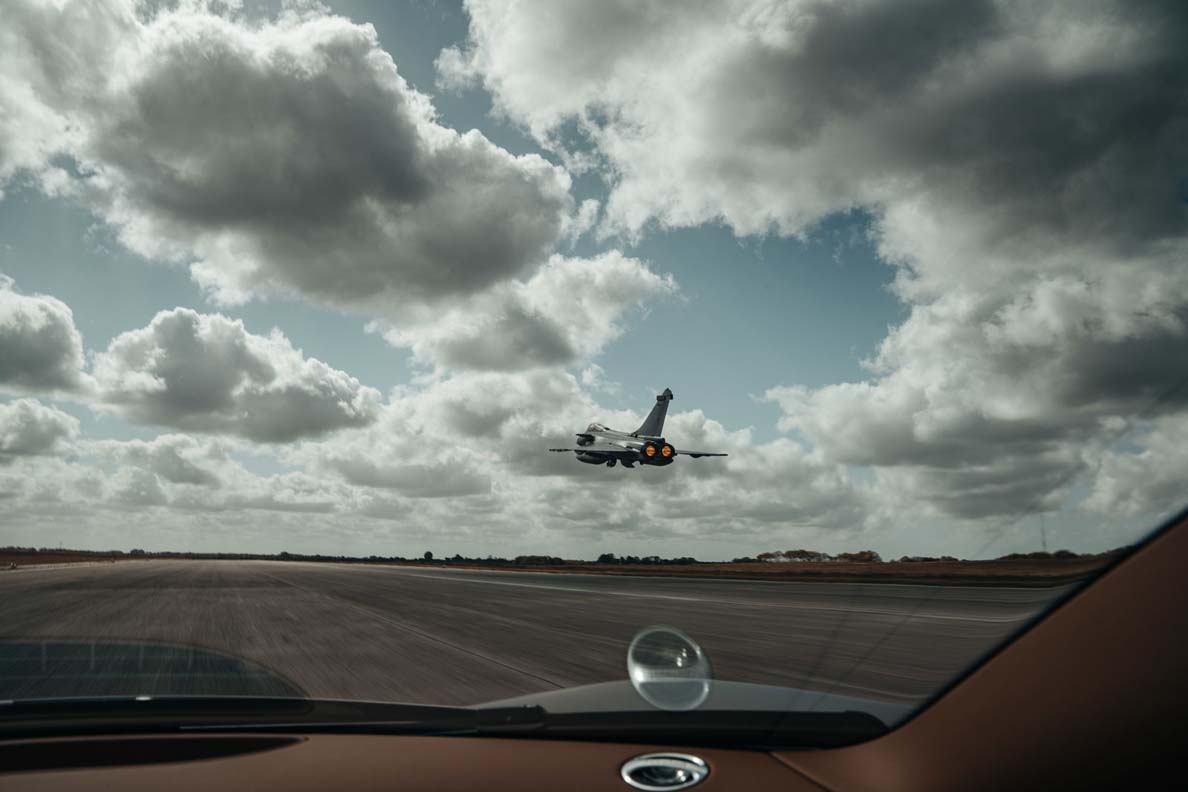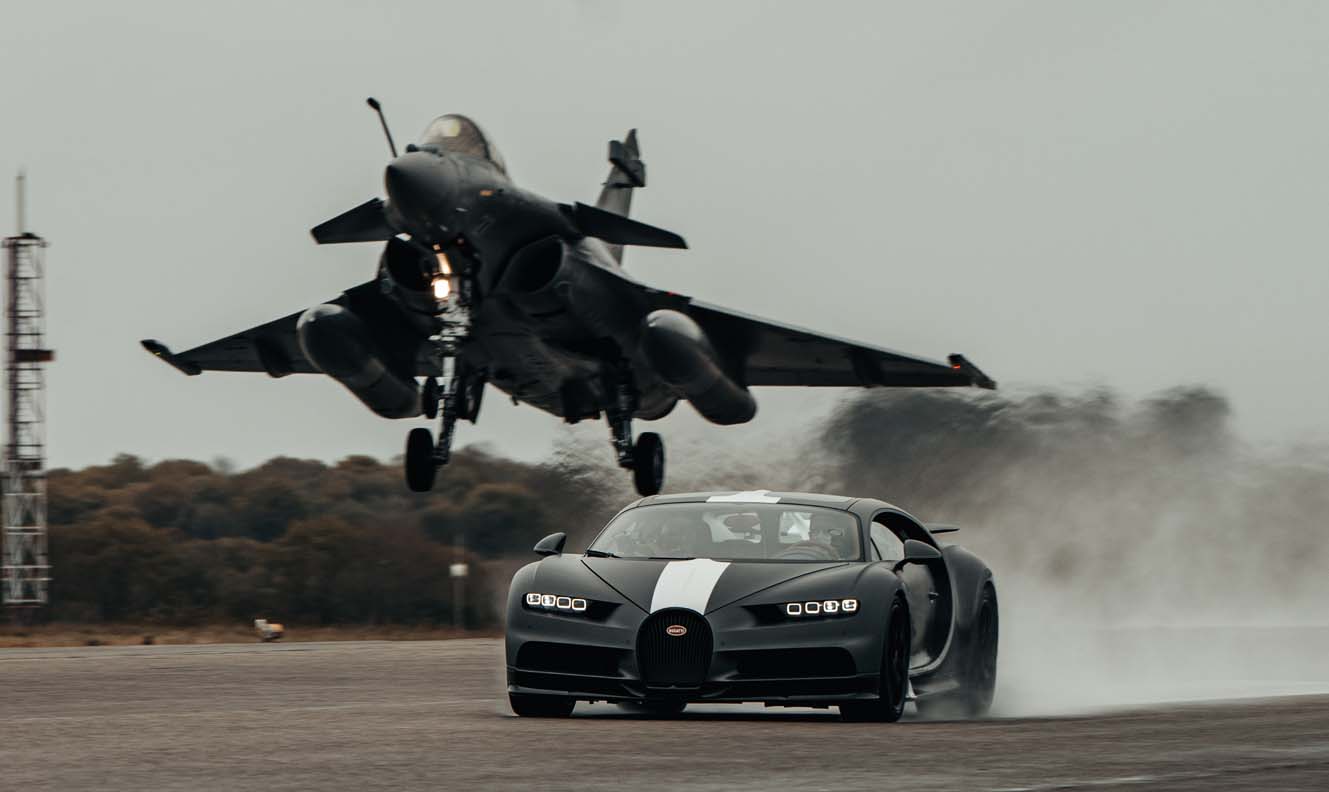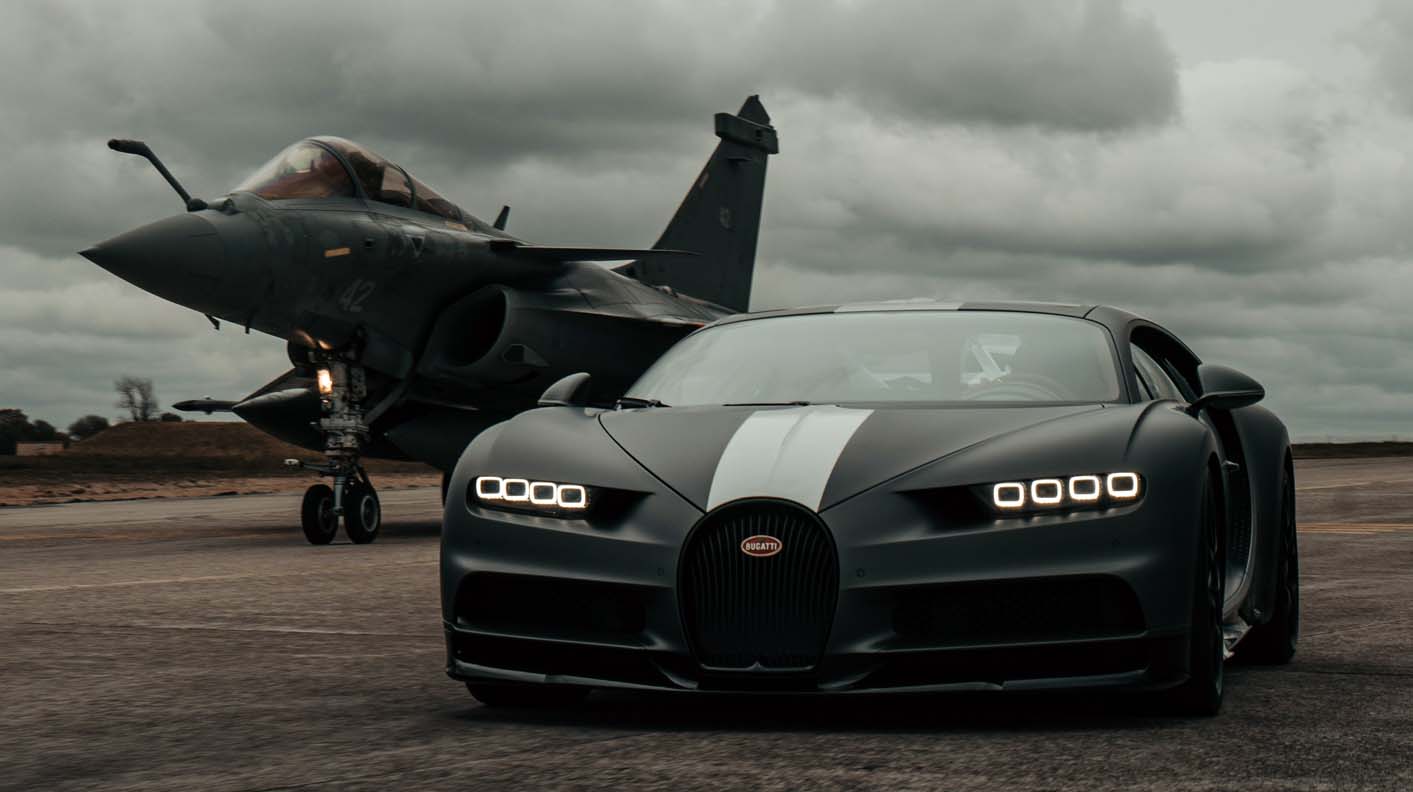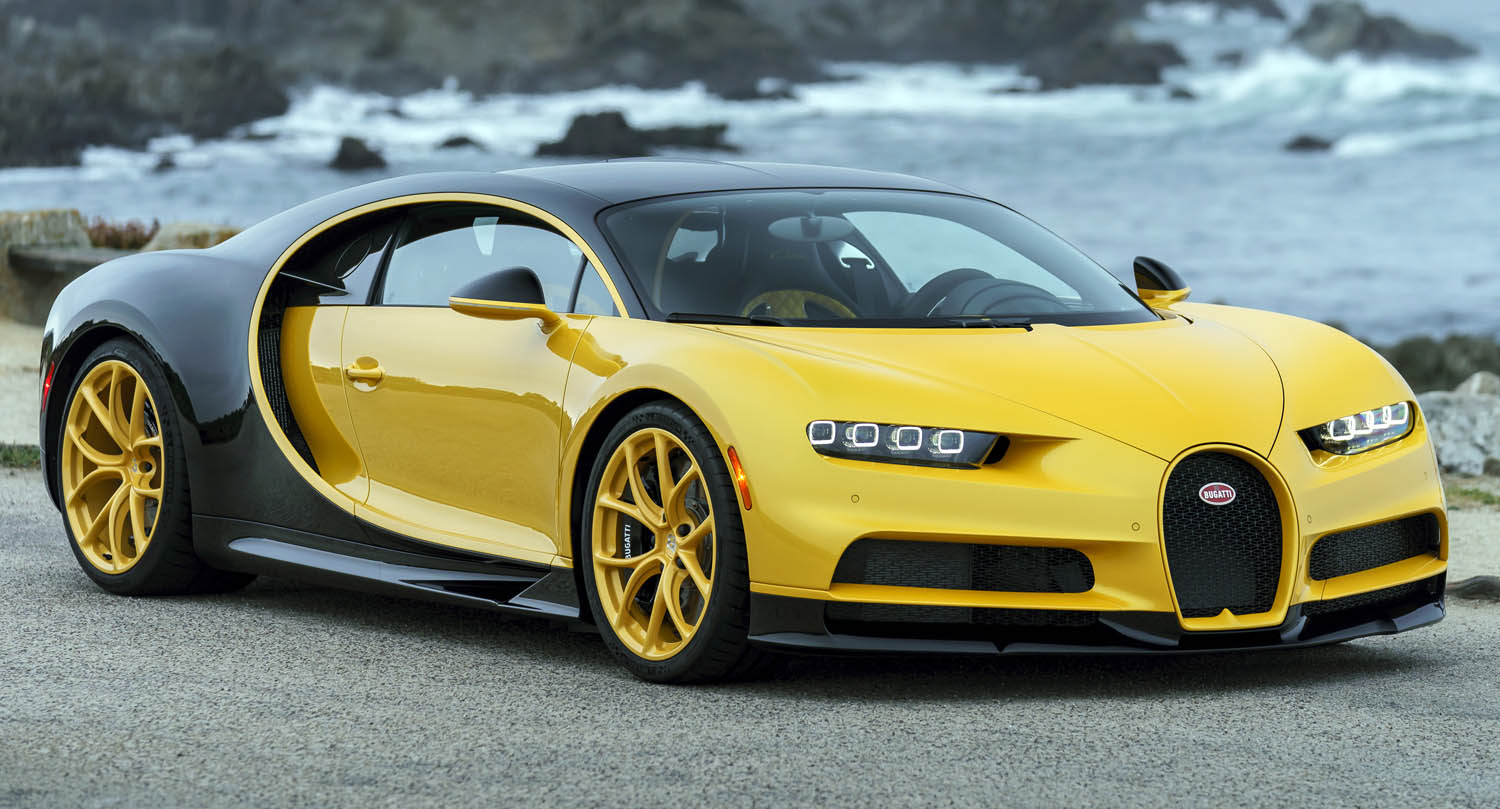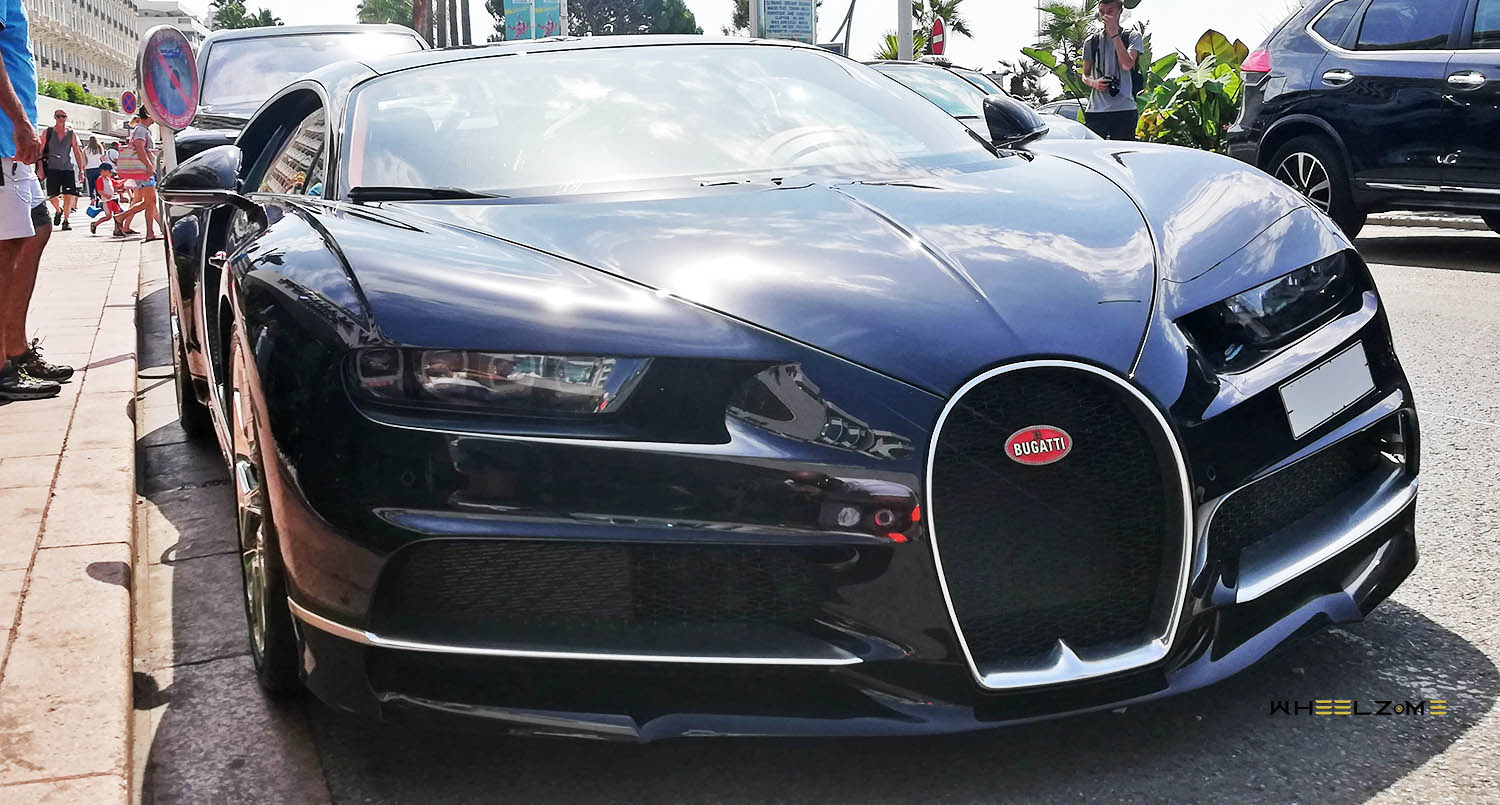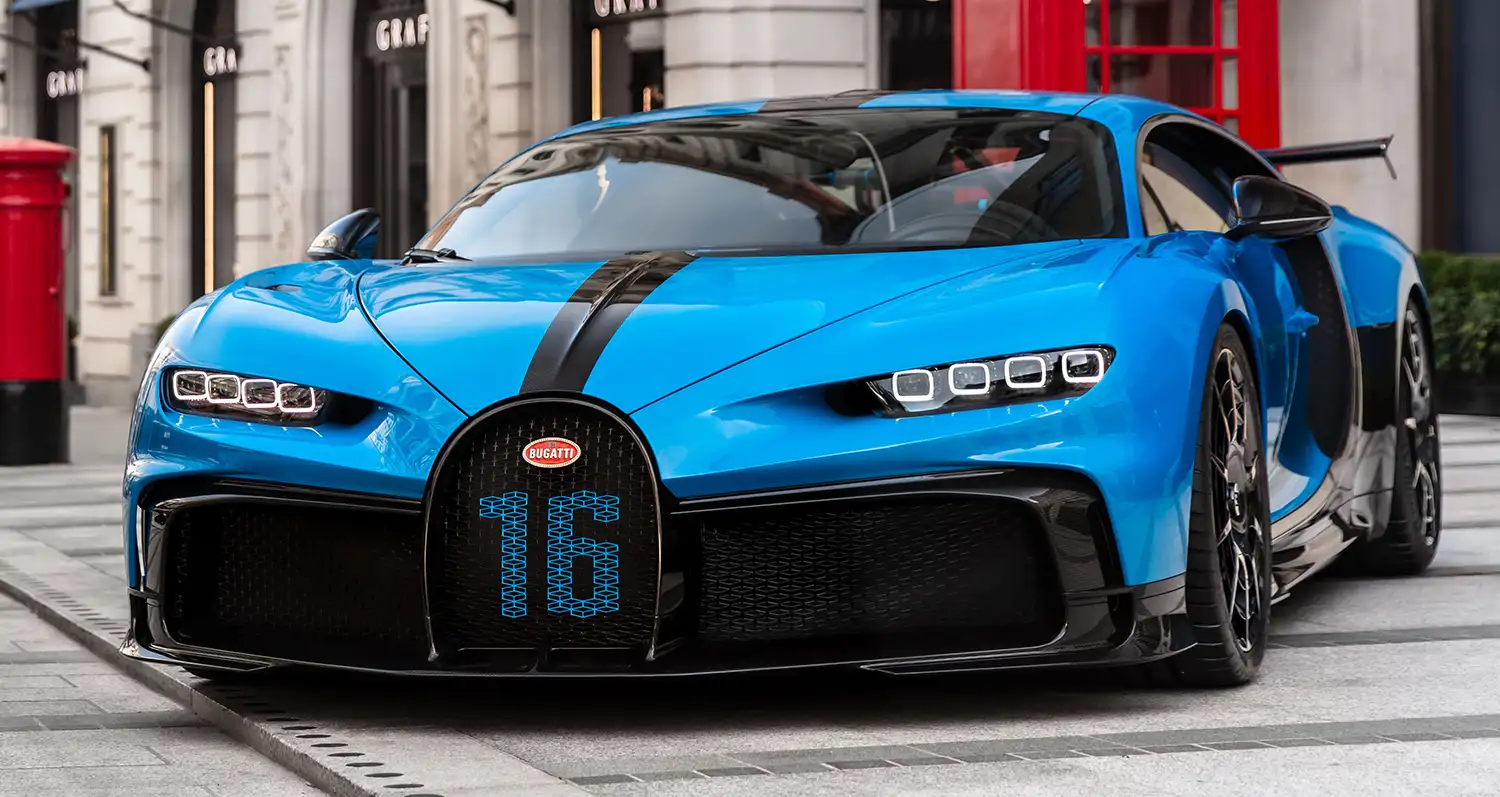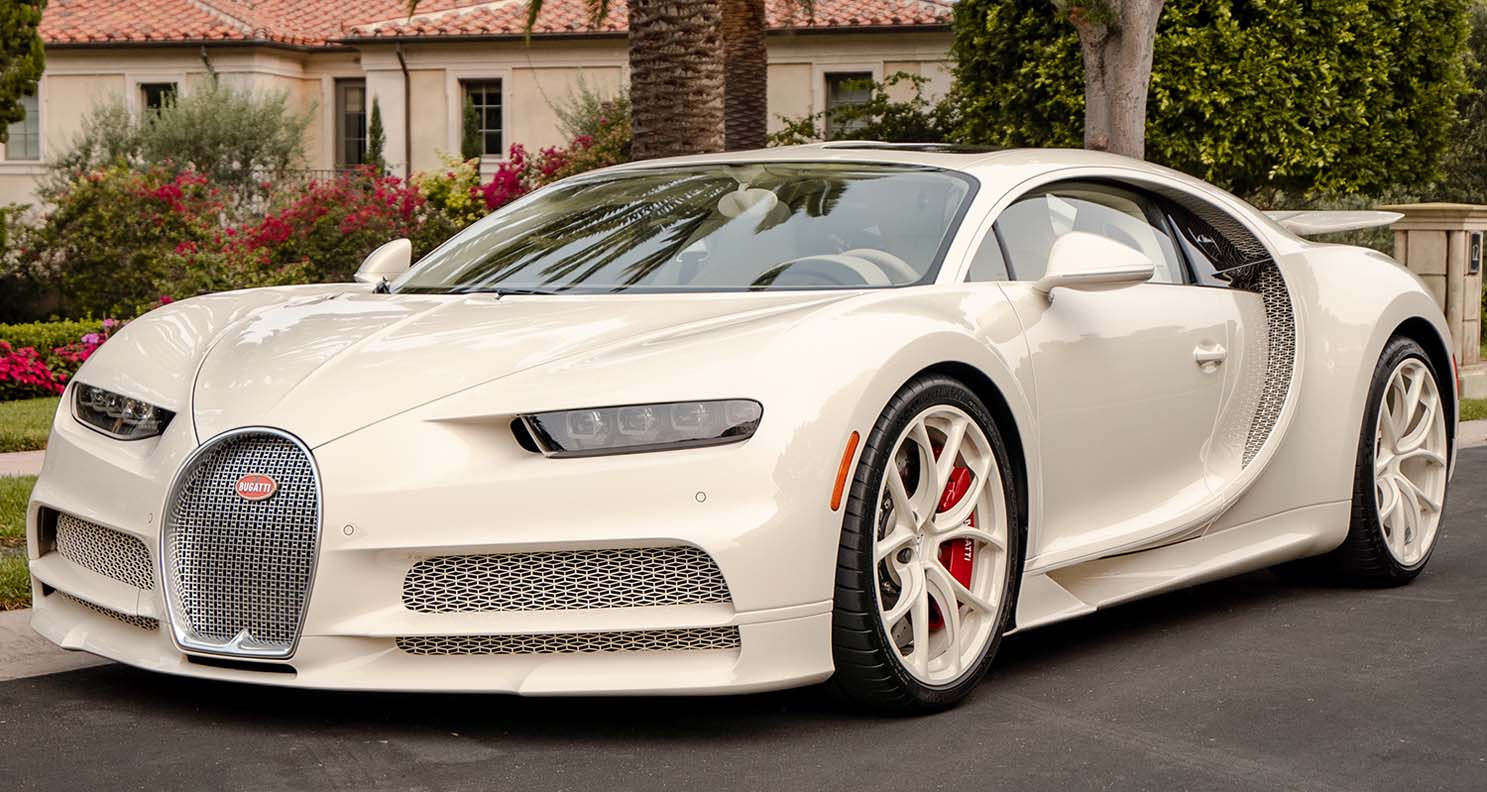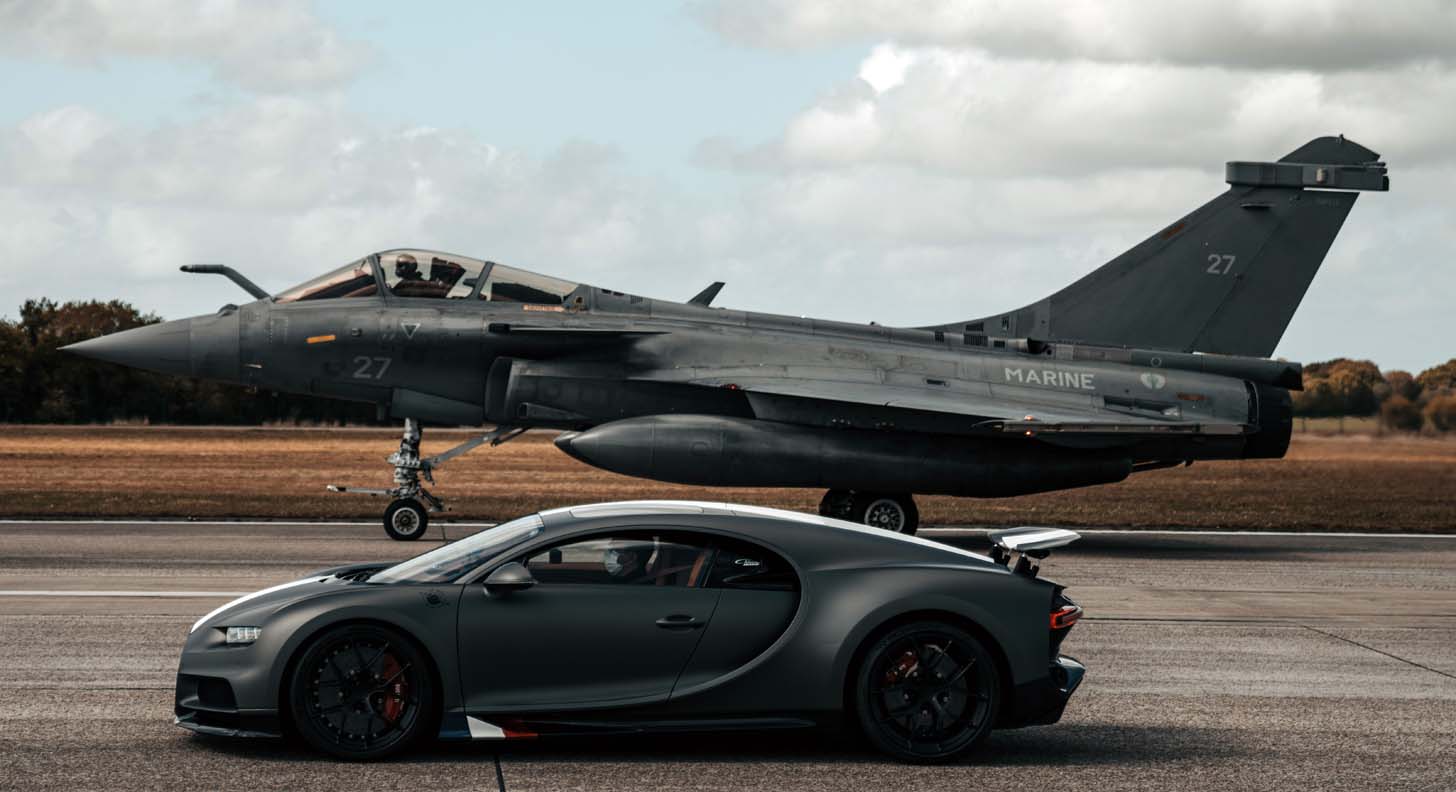
The driver and the pilot both look ahead, highly focused. They wait for the starting signal. The famous French Tricolor drops and moments later, the asphalt begins to vibrate. The two set off alongside one another. The driver and the pilot look into the horizon and go full throttle. With tires on smooth tar, two engines ignite their afterburners and proverbially light up the black surface. The two machines of kin and shared legacy roar and disappear out of view in a matter of seconds.
Video
This is the start of an extraordinary match-up in Landivisiau, north-west France: the Bugatti Chiron Sport1 alongside the Dassault Rafale Marine. 1,500 PS up against 58,550 newtons of thrust (5,727 PS), a hyper sports car up against a Navy jet. The two high-technology products from France are at the top of their respective fields and stand for the technical progress made after decades of development work in automotive and aerospace engineering.
Two professionals occupy the cockpits – Bugatti’s pilote officiel Pierre-Henri Raphanel in the Chiron Sport and frigate captain Etienne in the Rafale Marine. They and their teams have been preparing for this day for weeks. The tension leading up to the start is immense for everyone involved.
Setting the most incredible scene
With its outstanding performance and incredible top speed, the Bugatti Chiron Sport is almost peerless in the automotive world. A Bugatti has gone toe-to-toe with a jet before. A Veyron 16.4 took on a Eurofighter Typhoon in a drag race in 2007. In the current match-up, the Bugatti Chiron Sport and the Dassault Rafale Marine are seeing how they measure up against one another in disciplines like acceleration, torque and braking behavior.
It’s an elaborate process that involves planning to even the most minute detail. Even a short flight calls for extensive preparation and follow-up. “Precision and preparation are everything. Everything happens very quickly in the Rafale Marine and every move you make has to be right. And the same goes for the Chiron Sport at high speeds,” explains Navy pilot, Etienne. “At high speeds, everything has to go perfectly both in the Chiron Sport and the Rafale Marine. Because the runway isn’t all that long or terribly wide for the both of us. This comparison will be a challenge for everyone,” adds Pierre-Henri Raphanel, Bugatti’s pilote officiel.
Bugatti’s aviation history
Bugatti has held close links with the aviation world for more than 110 years. Many of the successful Bugatti race car drivers, such as Albert Divo, Robert Benoist, and Bartolomeo “Meo” Costantini, flew for the French Air Force at the beginning of the last century. The legendary French aviator, Roland Garros, owned a Bugatti Type 18 in order to be as fast on the ground as he was in the air.
Company founder, Ettore Bugatti, marveled at his drivers’ courage and technical understanding. The race car drivers benefited from their experience in the aircraft cockpit and applied it to the road. The pilots were fascinated by Bugatti’s agile, light, and fast automobiles that mirrored the performance of their aircraft.
Around 1915, Ettore Bugatti was himself developing airplane engines, and from 1937 the company founder worked on developing an entire aircraft that would break speed records. The project then had to be discontinued due to the outbreak of the Second World War.
Bugatti Chiron Sport Edition ‘Les Légendes du Ciel’
It was therefore only logical for Bugatti to unveil the Chiron Sport ‘Les Légendes du Ciel’ at the end of last year, limited to just 20 units. It is the French luxury marque’s way of honoring French aviation and the former Bugatti drivers of the golden age who also piloted airplanes. Since it was revealed the Chiron Sport ‘Les Légendes du Ciel’ forges a link between the past and the present.
The limited edition Bugatti features attributes to aircraft, such as the Gris Serpent matte grey paintwork and the blue, white, and red Tricolor, which adorns the front of the side skirts made from black visible carbon fiber. The bars of the radiator grille are made from laser-cut, deep-drawn aluminum and are reminiscent of planes in a flyby formation. A brushed aluminum door sill panel with the lettering ‘Les Légendes du Ciel’ identifies the edition.
It has a leather interior in the Gaucho color which is reminiscent of the natural leather used in airplanes in the past. This natural material is contrasted with aluminum trims and an aluminum inlay featuring the ‘Les Légendes du Ciel’ logo, which also features on the headrests. On the door panels, there is a sketch of a racing scene between the Nieuport 17 airplane and a Bugatti Type 13 that represents the two historical links commemorated by the limited edition hyper sports car.
The appropriate power is provided by the 8.0-liter W16 engine with 1,500 PS and torque of 1,600 newton meters. A seven-gear dual-clutch transmission transfers the power to all four tires. The edition, limited to 20 units, retails at a net price of 2.88 million euros.
Behind the steering wheel sits a man of speed and precision in the cockpit: Bugatti’s pilote official, Pierre-Henri Raphanel. He took part in the 24 Hours of Le Mans 14 times between 1986 and 2000, finishing second twice and once winning the GT category, won the French Formula 3 championship in 1985, and, four years later, qualified for the Formula 1 grand prix in Monaco. The race car driver has been assisting Bugatti with his expertise for more than 10 years and in 2010, he broke the speed record for road-legal super sports cars for Bugatti in a Veyron 16.4 Super Sport (431,072 km/h / 268 mph).
He has been test-driving the hyper sports cars from Molsheim on various roads as well as tracks and with customers ever since. But this encounter between the Dassault Rafale Marine and the Chiron Sport is a first for him, too. “We may only be driving straight ahead on a runway but setting off alongside a jet demands a great deal of attention and concentration, especially at high speeds,” explains Pierre-Henri Raphanel. With the Chiron Sport, it is the combination of seemingly never-ending power output and torque that delivers this incredible thrust. As soon as the flag drops, the Bugatti accelerates unrelentingly all the way to the end of the runway.
Dassault Rafale Marine
Alongside the Chiron Sport is the Rafale Marine, the pride of French Navy aviation. After France left the Eurofighter program, the French company Dassault developed its own aircraft; one which was uncompromisingly tailored to the requirements of the French army. This includes the ability to be able to take off over especially short distances. This is possible thanks to its virtually tailless delta wing construction in a mid-wing design with canard wings. It is a light, versatile, land- and carrier-based multirole aircraft.
The twin-engine jet has been in the service of the French armed forces since 2000. It has a dry weight of 10.3 tons, a maximum weight of 24.5 tons and is used for a variety of tasks. With its length of 15.5 meters and a wingspan of 10.86 meters, the Rafale Marine – in single-seater configuration for the Navy – can achieve a top speed of more than 1.6 Mach or around 1,975 km/h. But what really sets it apart is its maneuverability. It can take off from and land on aircraft carriers like the Charles de Gaulle. Around 200 Rafale aircraft have been produced to date, 46 of which are Rafale Marine jets.
“The Rafale Marine is easy to fly, highly versatile, and very fast and it also looks elegant and slick. It’s a great aircraft, but it does demand complete concentration for every maneuver,” explains Etienne. He should know as he has been flying for 20 years and currently works as head of Operations at the base d’aéronautique navale in Landivisiau. In 2006, he earned his fighter pilot certification and qualified to land on the aircraft carrier Charles de Gaulle. He has been flying the Rafale Marine for five years and has notched up over 2,000 flight hours in jets as well as more than 500 catapult take-offs and landings on the aircraft carrier. Between 2017 and 2019, he has been Commander of Flotilla 12F, a flotilla with a long history.
French naval aviators
Like Bugatti, French naval aviators can look back on a long history. The first seaplanes were developed in around 1910 and nine years later the French pilot, Paul Teste, developed a wheeled plane that could take off from ships. It took off from the deck of the aviso Bapaume for the first time in 1919, and the first landing on a converted ship was achieved a year later. With the newly developed appontage landing technique, ropes and tailhooks bring the aircraft to a standstill within a distance of 30 meters. This technique is still used to catch jets on aircraft carriers to this day, such as on the Charles de Gaulle, the flagship in the French Navy.
The Landivisiau Naval Air Base (BAN Landivisiau) in Brittany serves the French naval aviators as a base for their deployments on the aircraft carrier and it is from here that they practice takeoffs and landings. Aircraft have been taking off from Landivisiau since 1965; initially two squadrons of both the Dassault Etendard and the Vought F-8 Crusader, and later the Super Etendard. The Dassault Rafale Marine has been stationed in Landivisiau since 2000 and there are currently 41 aircraft there divided into three flotilla: 11F (established in 1920), 12F (1948), and 17F (1958).
The comparable Bugatti Chiron Sport and the Dassault Rafale Marine
These two French icons have a lot in common. Ettore Bugatti founded his company in Molsheim, France, in 1909 and the French army introduced naval aviators in the following year. The Rafale was first deployed by the army in 2001, the year in which Bugatti unveiled the Veyron 16.4. The fleet at the Landivisiau base has consisted exclusively of the Rafale Marine since 2016, the year in which Bugatti introduced the Chiron2.
The two extremes of their respective field share common ground in terms of technology and materials, too. “The Chiron Sport and the Rafale Marine have more in common than they don’t. They are both absolutely high-tech products, are manufactured with passion and precision, are beautiful and incredibly powerful and fast, can be maneuvered and can brake precisely like no other,” says Etienne.
The brakes of the Rafale were developed by Messier-Bugatti, a company that can be traced to Bugatti Automobiles in Molsheim. The brake block with a diameter of 33.8 centimeters weighs around 27 kilograms. Ten pistons apply pressure of 175 bar to the brake disks. An anti-skid system developed especially for aircraft keeps the jet on track even during tricky landings. A special heat shield on the brake protects the 36-kilogram alloy wheels and the 790×275-15 Michelin tires from overheating.
The tires of the Chiron Sport are a little smaller, but no less impressive, with 285/30 R20 ZR tires at the front, 355/25 R21 ZR at the back. In the Chiron Sport, brake disks with a diameter of 420 millimeters at the front and 400 millimeters at the back ensure safe braking. Eight brake pistons at the front and six pistons per brake caliper at the back bite into the disks.
To compensate for the extreme heat during landings, the jet’s tires are filled with nitrogen as they have to withstand temperatures ranging from –30 to +199 degrees. The pressure of 16 bar is sufficient for land-based landings, but this is increased to 27 bar for landings on aircraft carriers. In the Chiron Sport, the tire pressure is increased from 2.8 to 3.0 bar for the top-speed mode.
Around 70 percent of the aircraft’s skin consists of the composite materials carbon and Kevlar, which means the weight is reduced by approximately 30 per cent compared with aluminum. Aluminum does feature in the aircraft structure, together with titanium.
Bugatti has a long tradition of lightweight construction. Many of the materials used in aircraft construction also feature in the latest hyper sports cars. For example, high-strength stainless steels such as aircraft stainless steel are used for the Chiron’s wishbones. High-strength threaded bolts made from titanium are used to connect the Chiron’s driver’s cab to the drive unit. The brake caliper pistons are made from this material, too. The exhaust system with a volume of 68 liters is likewise made from titanium, while the exhaust cover is made with high-temperature-resistant nickel-based alloys (Inconel). Bugatti places its trust in high-strength aluminum for the brake calipers as well as for the entire front end with its clever crash test structure and rear wing mechanism. Extreme stability coupled with low weight is achieved thanks to the center and rear structural components and the entire skin made from carbon. Even the windscreen wiper arms are made from this light material.
In addition to the materials it uses, Bugatti embraces aviation with its adaptive chassis, too. The Chiron is the first automobile to feature an entirely hydraulically adaptive chassis, just like the landing gear of a jet. The only difference is that the landing gear of the Rafale Marine is withdrawn hydraulically, while the Bugatti’s chassis adapts on the basis of various driving programs. In the Top Speed program, for example, the Chiron Sport drops 3.5 centimeters at the front and 3.1 centimeters at the rear in comparison to the EB program.
Bugatti takes inspiration from aviation with the development of its hyper sports car’s aerodynamics, too. Whereas an aircraft uses the shape of its wings to generate lift, a different wing on the automobile generates downthrust for good roadholding, using the same principle to achieve the opposite effect. For the Chiron Sport, to be able to brake safely even at its top speed of 420 km/h, just like on a jet, the rear wing is raised from its angle of three degrees to 49 degrees in the Top Speed mode to serves as a brake flap. Bugatti controls this active aerodynamics at the rear and front with a total of 18 hydraulic cylinders.
There are even similarities in the Chiron Sport and the Rafale with regard to the human-machine interface and its operation. During a flight, the pilot controls the majority of the control elements via a joystick. This ‘hands on handle’ principle is made possible by 24 buttons on the throttle and its extension as well as 13 on the clutch. In the Chiron Sport, the majority of the functions are controlled via the multifunction steering wheel, meaning there is no need for the driver to take their hands off the steering wheel. The Rafale Marine is equipped with five screens for visualization, while the Chiron has two in the cockpit and four on the air conditioning controls.
The encounter between the Chiron Sport and the Rafale Marine
Returning to the scenario at hand: the Bugatti Chiron Sport takes the lead soon after setting off. The hyper sports car accelerates from 0 to 100 km/h in 2.4 seconds and to 200 km/h in 6.1 seconds. It takes 13.1 seconds to hit a speed of 300 km/h and 32.6 seconds to accelerate to 400 km/h, a speed at which pilot, Etienne, and the Rafale Marine look to match to take off.
The aircraft hits 165 km/h after 150 meters and 210 km/h after 250 meters, and takes off after 450 meters at around 260 km/h. “I pulled away from the Rafale over the first few hundred meters, but after a few hundred meters more it was around 20 meters above and alongside me in the air. An incredible and fantastic sight,” says Pierre-Henri Raphanel later. To be on the safe side, the Bugatti driver initiates his braking maneuver after approximately 1.5 kilometers and over 350 km/h – by which time the Rafale has disappeared into the horizon.
There are similarities between the two systems when looking at the exhilarating acceleration. The feeling in the Rafale Marine is the same as in the Chiron Sport. It’s a feeling of seemingly never-ending thrust, of an abundance of power. “The Chiron Sport has incredible acceleration force which comes very close to that of the Rafale. What you feel in the Bugatti is what you feel in the jet, including when braking,” explains pilot Etienne. Like in “Top Gun”, the Rafale Marine briefly flies over the runway and alongside the Chiron Sport – an amazing image. “But the reality with the Rafale Marine and the Chiron Sport is even better,” says Etienne.
The Chiron Sport likewise delivers top performance when accelerating: it goes from 50 to 150 km/h in 3.2 seconds, from 80 to 120 km/h in just 1.8 seconds, and from 100 to 200 km/h in 4.3 seconds.
To be able to decelerate stably at high speeds, both machines use extra-special brakes. It takes the Bugatti Chiron Sport 491 meters to come to a standstill from 400 km/h and 247 meters from a speed of 300 km/h. It travels 114 meters when decelerating from 200 to 0 km/h and 31.4 meters to get down from 100 to 0 km/h. Due to the shortness of the runway and the safety regulations, the Chiron Sport brakes at just 210 km/h and the Rafale Marine at 250 km/h.
To compare its braking performance with that of the Chiron Sport, the Rafale Marine approaches the runway at approximately 280 km/h (150 kt), makes contact with the ground, and catches the arresting gear with its tailhook on the rear, just like on an aircraft carrier. Etienne is thrust into his seat belt and the machine comes to a standstill within 150 meters. “It’s a very extreme sensation, as if you were driving into a wall or like a controlled fall,” he says, describing the maneuver. The Chiron Sport, meanwhile, brakes powerfully, but more softly. “With the air brake at the rear, the Bugatti remains incredibly directionally stable, even during abrupt braking maneuvers down from high speeds,” explains Pierre-Henri Raphanel.
The comparison of France’s top two technical systems is therefore declared a draw. They share more in common than what sets them apart from one another – in terms of technology and driving/flying behavior as well as emotionally. “Setting off alongside and so close to the Rafale Marine was an incredible experience,” explains Pierre-Henri Raphanel. To which Etienne adds: “The Chiron Sport is the ideal vehicle for navy pilots.”
